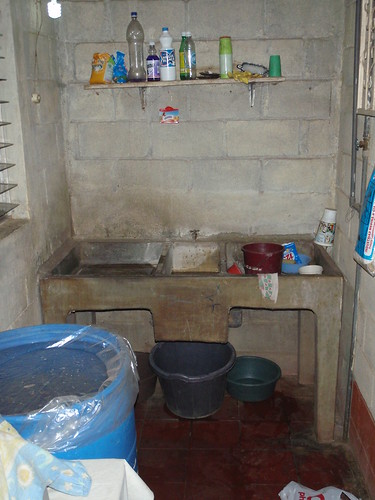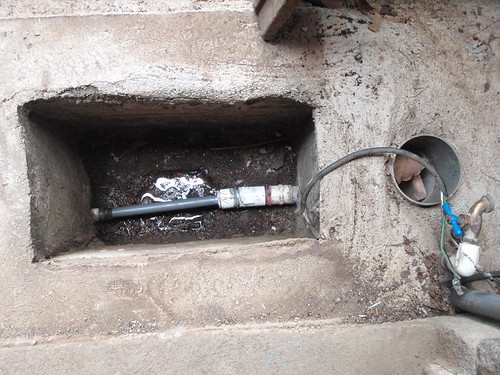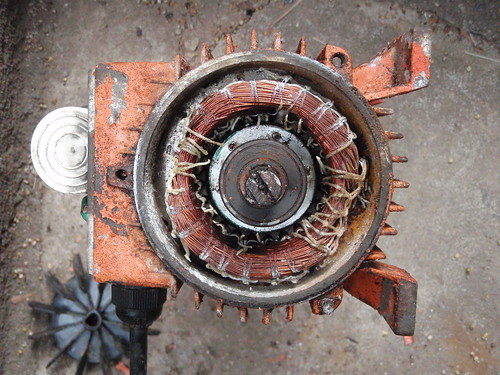 |
| Doing laundry |
|
I have figured out how to take a shower with less than one gallon of water: It starts with a bucket of water and a small plastic bowl. I scoop water out of the bucket and pour it over my hair. I then rub the water that has dripped and splashed down off my hair over as much of my upper body as I can. I take another small scoop and get the rest of my arms and torso wet. Then comes the shampoo and soap – it helps to use liquid soap – which I lather into my hair and upper body. The next scoop of water rinses off the soap, and trickles down over the rest of my body, helped by my hands to get the spots gravity didn't find. More soap as needed, and then rinse the lower body, and you're done! If you wash in a wide bucket, you can then use that water to flush the toilet.
 |
| Agua Bastante: one night's collection. |
In the first ten days of living in the Casa Misionera, my house got water five nights – one of which I slept through – after a six day stretch with no water. The Casa, like most houses in the neighborhood, has indoor plumbing, but water in Managua comes on sporadically. It tends to arrive here sometime between 2 and 5 in the morning, although just a block further downhill, it will come closer to 10 PM. We all have storage vessels – tanks, barrels, buckets, and bottles – to keep what we need for the day, or in some cases the week. The Casa has one 50 gallon barrel, two five gallon buckets with lids, five large open buckets that hold about 20 gallons in total, and twelve one-gallon jugs. I figure I can go up to about three weeks, without having to skip showers or washing clothes, if needed. Of course, as a gringo, it is not recommended that I drink this water, so I buy five gallon jugs of drinking water from the pulpuria next door every few days. Rather than see it as an inconvenience, I love this relationship with water! Clean water is becoming an increasingly
scarce resource in our global industrial society, thanks to the spread of
factories and air pollution,
increased urban use, and destruction of our natural ecosystems. I want to be conscious of my water use, and to minimize it while I keep in mind that my behavior, wherever I am, affects others' access to clean water. That's harder to do when I pay pennies for water that flows whenever I turn a knob.
 |
| The utility sink |
The first night that I woke in time to catch the water, I heard the sound of splashing next door, as well as the hum of my neighbor's pump. Pumps have become more popular in the neighborhood, as the municipal system offers just a trickle of water most days, and it takes far less time to fill your containers with the pump. Of course, this means that those without pumps get less water than they would otherwise while you are pumping. That first night with water I ran excitedly from my bed and turned on the tap, only to find that Gladys' pumping meant that I got none. I went back to bed, and lay awake until the pump turned off, when I tried again. I managed to collect about eight gallons before the water cut out again – more than enough for me for one day. The next night, the water came on again, at about 4:30, and I was able to collect another eight gallons. Gladys didn't need to pump, as she had collected enough the night before. Finally, after about a week, the water came on at about 2:30 in force, and I filled every container in the house and I was able to turn the tap off for the first time, at about 4 AM. You can imagine what this does to one's sleep schedule, and of course we go to bed with one ear open to listen for the water.
 |
| Catching water |
It turns out that the Casa Misionera also has a pump, and a tank on the roof, which would allow us to use the plumbing whenever it is full. At first I wasn't a fan of the pump, as I felt like using it would deprive my less-privileged neighbors of water, as Gladys' pump had done me that first night. However, seeing how getting a full water collection allows one to skip nights of collecting, I felt a little better about it. I also I imagine sharing water with my neighbors in need – sharing is one of my favorite ways to build relationships and goodwill in community. Our pump, though, was broken. The previous inhabitants of the house, who bought the pump in the first place, had left the pump on long enough when there was no water that it overheated and stopped working. I had offers from two friends to help fix it: Fernando, who has been without work since returning to be with his family after a year working in Costa Rica, and Jerry, a young man who maintains his family's pump. Another thing I love about Nicaragua is the common practice of do-it-yourself repairs. Fernando removed the pump from the plumbing and put a provisional pipe in its place, and helped me get started taking the pump apart, and then Jerry came and had a look at it, finished taking it apart, and gave the final verdict: the copper wires were burned through – the only thing this pump was good for was recycling. We gave the pump to some kids, who will get 40 cordoba per pound for the
copper, and maybe a little for the rest of the pump.
 |
| Fernando installed a temporary fix |
 |
| Bomba no sirve |
My aspirations of working faucets dashed, I get to continue my ultra low-use practices. Now the question is whether to invest in a new pump, or keep collecting water in half-gallon increments out of the backyard faucet?






No comments:
Post a Comment